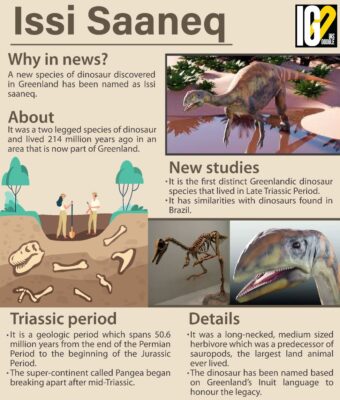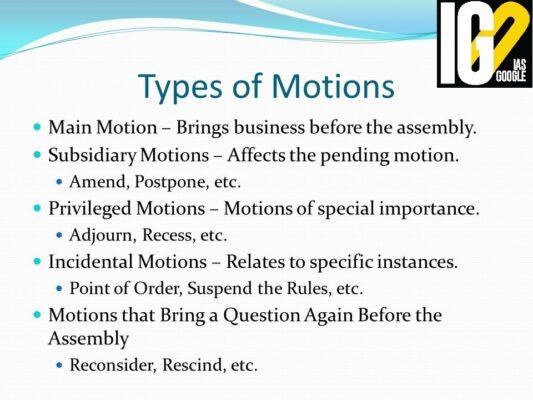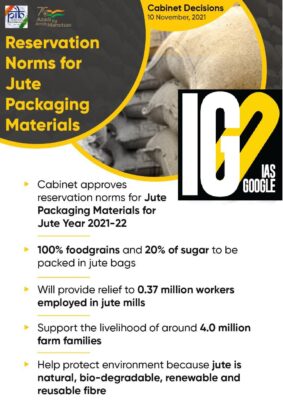- Home
- Prelims
- Mains
- Current Affairs
- Study Materials
- Test Series
13th Nov 2021
ISSI SAANEQ: NEW DINOSAUR SPECIES, WHICH ROAMED GREENLAND 214 MN YEARS AGO
A new dinosaur species, named Issi saaneq, has been discovered that lived on Greenland.
Features:





- It is a two-legged dinosaur that lived in Greenland.
- It lived during the Late Triassic Period (between 237 Ma 201.3 million years ago).
- It was a medium-sized, long-necked herbivore and a predecessor of the sauropods.
- Sauropods-The largest land animal.
- The name of the new dinosaur pays tribute to Greenland’s Inuit language and and means “coldbone”.
- It has similarities with dinosaurs found in Brazil, such as the Macrocollum and Unaysaurus, which are 15 million years older.
- The new findings are the first evidence of a distinct Greenlandic dinosaur species as this species differs from other Sauropodomorphs.

- E-Amrit is a one-stop destination for all information on electric vehicles such as purchase, investment opportunities, policies, subsidies etc.
- The portal has been developed and hosted by NITI Aayog under a collaborative knowledge exchange program with the UK government.
- As part of the UK–India Joint Roadmap 2030, signed by the Prime Ministers of the two countries.
- Developed and hosted by: NITI Aayog under a knowledge exchange program with the UK government as part of the UK–India Joint Roadmap 2030.
- Aim: to complement initiatives of the government on raising awareness on EVs and sensitizing consumers on the benefits of switching to electric vehicles.

- All Members of Parliament (MPs) enjoy rights and immunities, individually and collectively, so that they can discharge their duties and functions effectively.
- Any instance when these rights and immunities are disregarded by any member of Lok Sabha or Rajya Sabha is an offence, called ‘breach of privilege’, which is punishable under the Laws of Parliament.
- Any member from either house can move a notice in the form of a motion against the member who he/she thinks is guilty of the breach of privilege.
- Both Houses of the Parliament reserve the right to punish any action of contempt (not necessarily breach of privilege) which is against its authority and dignity, as per the laws.
- The rules governing the privilege are mentioned in the Rule No 222 in Chapter 20 of the Lok Sabha Rule Book and Rule 187 in Chapter 16 of the Rajya Sabha rulebook.
- The rules explain that any member of the House may, with the consent of the Speaker or the Chairperson, raise a question involving an incident that he or she considers a breach of privilege either of a member or of the House or of a committee.
- The notice has to be about a recent incident and should need the intervention of the House.
- These notices have to be submitted before 10 am to the Speaker or the Chairperson of the House.
- The speaker of Lok Sabha and the Chairperson of Rajya Sabha are the first level of scrutiny of a privilege motion in the two Houses of Parliament.
- They can either take a decision on the privilege motion or can also refer it to the privileges committee of Parliament.
- Once the Speaker or the House Chairperson gives consent under Rule 222, the concerned member is allowed to explain himself or herself.
- The chairperson of the house nominates a committee of privileges consisting of 15 members of parliament as per respective party strengths, in Lok Sabha and 10 members in the Rajya Sabha.
- The deputy chairperson heads the committee of privileges.
- The report prepared by the committee is submitted to the House for its consideration.
- The chairperson may also allow a half-hour debate on the report by the committee before passing orders or directing that the report be tabled before the House and thereafter a resolution is passed.
- Freedom of speech in Parliament
- The immunity granted to members under article 105(2),covers anything said in Parliament even though it does not strictly pertain to the business before the House
- Immunity to a member from any proceedings in any court in respect of anything said or any vote given by him in Parliament or any committee.
- Immunity to a person from proceedings in any court in respect of the publication of any report, paper, votes or proceedings under the authority of either house of the government.
- No officer or Member of Parliament empowered to regulate procedure or the conduct of business or to maintain order in Parliament can be subject to a court’s jurisdiction in respect of exercise by him of those powers.
- No person can be liable to any civil or criminal proceedings in any court for publication in a newspaper of a substantially true report of any proceedings of either House of Parliament unless the publication is proved to have been made with malice.
- Apart from the privileges as specified in the Constitution, the Code of Civil Procedure, provides for freedom from arrest and detention of members under civil process during the continuance of the meeting of the House or of a committee and forty days before its commencement and forty days after its conclusion.
- The MCDR has been framed under section 18 of the Mines and Minerals Act, 1957.
- Aim: To provide rules regarding conservation of minerals, systematic and scientific mining, development of the mineral in the country, and for the protection of the environment.
- The amendments in the Rules are as follows:
- Rules prescribed that all plans and sections related to mine shall be prepared by combination of Digital Global Positioning System (DGPS)as may be specified by the Indian Bureau of Mines (IBM).
- New Rule inserted to provide for submission of digital images of mining area by lessees and Letter of Intent holders.
- Requirement of submitting satellite images obtained from CARTOSAT-2 satellite LISS-IV sensor on the scale of the cadastral map.
- CARTOSAT-2 satellite: is an Earth observation satellite in Sun-synchronous orbit satellites. The satellite was built, launched, and maintained by the Indian Space Research Organisation
- Power of taking action against incomplete or wrong or false information in monthly or annual returns given to IBM, in addition to State Govt.
- Allowed engagement of a part-time mining engineer or a part-time geologist for category 'A' mines having leased area below 25 hectares.
- To increase employment opportunity, a diploma in mining and mine surveying is granted by the duly recognized institute in qualification for full-time Mining Engineer.
- Penalty provisions in the rules have been rationalized.
- Provision of forfeiture of financial assurance or performance security of the leaseholder added in case of non-submission of final mine closure plan within the period specified.
- Amount of financial assurance increased to five lakh rupees for Category ‘A’ mines and three lakh rupees for Category ‘B’ mines from existing three and two lakh rupees.

- The Mandatory packaging norms approved for Jute Year 2021-22 provide for 100% reservation of the food grains and 20% of sugar to be compulsorily packed in jute bags.
- The reservation norms would protect the interest of domestic production of raw jute and jute packaging material in India, thereby, making India self-reliant in consonance with Atmanirbhar Bharat.
- By bringing into effect the provision of Jute Packaging Materials Act, the Government will provide relief to thousands of workers employed in jute mills and ancillary units as well as support the livelihood of jute-based farm families.
- It will help protect environment because jute is natural, bio- degradable, renewable and reusable fibre and hence fulfils all sustainability parameters.
- Under the act, Government specifies the commodities and the extent to which they are mandatorily required to be packed in Jute Packaging Materials.
- On an average, the annual Government support to jute industry on this account amounts to Rs.5500 crores.
- To facilitate modernization in existing and new jute mills and up- gradation of technology in existing jute mills.
- To provide assistance to a large number of entrepreneurs to manufacture value added biodegradable Jute Diversified Products (JDP) as well as for modernization of technology.
- To support the small and marginal jute growers with adequate pre and post harvesting operations so that they can grow good quality jute & receive higher price for their produce.
- Make the growers aware about the latest technologies in the country.
- Under the scheme, the government is disseminating improved agronomic practices such as
- Line sowing using seed drills
- Nail weeders
- Distribution of certified seeds
- Providing microbial assisted retting
- It is an e-Governance Initiative for procurement of B-Twill Sacking.
- B-Twill Supply Management & Requisition Tool, in short, JUTE-SMART is a web-based application.
- Twill Jute Sack commonly known as jute sacking bags, are mainly used to pack rice, wheat, sugar, coffee bean, cocoa bean, peeper, shelled nuts and other grain products.
- To provide an integrated platform for all the stakeholders to allow easy access to information, more transparency and ease of doing business for the jute sector.
- To facilitate end to end transactions relating to procurement of B-Twill sacking.
- To provide financial incentive to the girl children of the workers of the Jute Mills/MSMEs, upon passing out Secondary and Higher Secondary examinations to encourage them to acquire the minimum required education for making them employable.
- Procurement of raw jute without any quantitative limit from the growers at the minimum Support price (MSP) based on the recommendations made by Commission for Agricultural Cost & Prices (CACP).
- Jute is a long, soft, shiny bast fiber that can be spun into coarse, strong threads.
- It is one of the most affordable natural fibers composed primarily of the plant materials cellulose and lignin.
- India is the world's largest producer of jute.
- Requires Plain alluvial soil and standing water.
- Soft water is necessary for jute production.
- Tropical lowland areas with humidity of 60% to 90%.
- It is a rain-fed crop with little need for fertilizer or pesticides
- Aim: Automation of the processes and functions of Directorate General of Civil Aviation (DGCA).
- Objectives:
- To provide a strong base for IT infrastructure and service delivery framework.
- The e-platform provides an end-to-end solution including various software applications, connectivity with all the regional offices.
- It is a ‘portal’ for dissemination of information and for providing online and speedy service delivery in a secure environment.
- The project would enhance the efficiency of the various services provided by the DGCA.
- It is the regulatory body in the field of Civil Aviation.
- It deals with safety issues.
- It was formed under the Aircraft (Amendment) Bill, 2020
- Headquarters- New Delhi
- Aim: to promote safe and efficient Air Transportation through regulation and proactive safety oversight system
- Function:
- It is responsible for regulation of air transport services.
- It also co-ordinates all regulatory functions with International Civil Aviation Organisation.
- It investigates aviation accidents and incidents.
- Licensing of pilots, aircraft maintenance engineers and flight engineers, and conducting examinations and checks for that purpose.
- Registration of civil aircraft.
- Approving training programs.
- Certification of airports.
- Keeping a check on aircraft noise and engine emissions.
- Manual scavenging is the act of cleaning sewers or removal of waste from toilets without the use of safety equipment.
- In simple terms, untreated human excreta are removed from pit latrines or bucket toilets using buckets or shovels by hand.
- There are three forms of scavenging as defined by the International Labour Organization:
- Septic tanks cleaning
- Removal of human excreta from dry latrines
- Gutters and sewer cleaning.
- Manual scavengers use basic tools such as a bucket lined with a sack and a handle. The worker then carries the waste manually and take it to the disposal sites.
- Manual scavenging constitutes problems that encompass domains of health and occupation, human rights and social justice, gender and caste, and human dignity.
- The major latrine used in urban areas is the dry latrines which are a major cause of manual scavenging.
- In rural areas, there are no strategies put forward to convert dry toilets.
- There is a lack of fully rehabilitating the sanitation workers.
- Lack of employment opportunities is a major concern.
- Also, lack of schemes that would help the families of manual scavengers contribute to existence of this practice.
- There are no proper strategies put forward to liberate manual scavengers psychologically.
- This pushes those in the practice to get even deeper and deeper into the practice of manual scavenging.
- People regard the manual scavengers as untouchable because of their work.
- Therefore, the society is not ready to accept and include them in community activities.
- No employer offers them a job and also, landlords bar them from renting their houses.
- The government and other major private institutions deny the existence of scavenging despite the deaths reported especially in India. As a result, no measures are taken to solve this problem.
- The scavengers are exposed to gases such as hydrogen disulphide, carbon (IV) oxide, ammonia, and methane. Long exposure to hydrogen di-sulphide can lead to death by asphyxia.
- The gas is also associated with visual acuity.
- Exposure to infections in the sewer is also common due to the numerous bacteria and rodents residing in the sewers.
- The common infection is the Leptospirosis which is an occupational disease in people who are in contact with an animal such as pigs.
- Manual scavengers are exposed to two types of violence that are social violence and violence associated with caste discrimination.
- Caste discrimination and the job condition can cause them to be exposed to physical violence.
- Most of the manual scavengers are women and members of the marginal class.
- The caste is regarded as a lower class and is excluded from moving to a better occupation.
- As a result, the scavenging work is seen as part of their natural occupation.
- Most manual scavengers are stigmatized by the community due to the nature of their job.
- They are regarded as untouchable and they are forced to accept their condition.
- It is necessary to involve all the major skate holders involved.
- They include the district officials, Relations officer, Chief Medical Officer, and District Supply Officer among any other relevant officials.
- The inclusion of the community around the areas that are most affected into the program is also of equal importance.
- District Nodal Officers, NGOs and health officers should educate the community on devastating effect caused by dry latrines.
- They should also educate the mass on health issues, hygiene practices, and sanitation.
- The public should be aware of the penalties they will face once they are arrested.
- The awareness campaigns should not only address the dangers of scavenging but also give the affected community an alternative method of making money.
- The same old model of pit latrine used by the community can be used to construct small pit toilets in a cost-effective manner.
- The funds that are released by the government and various campaigns should be put in good use.
- The officials managing the fund should then strategize on how the funds will be given to the community.
- The government should enforce the law that prohibits scavenging.
- The government should invest in pieces of machinery that can be used to clean ditches and septic tanks and provide the sanitation workers with quality protective gears.
- They can import the pieces of machinery or tools in case they are not locally available.
- The central government enacted The Employment of Manual Scavengers and Construction of Dry Latrines (Prohibition) Act in 1993.
- The act punishes the employment of scavengers or the construction of dry (non-flush) latrines
- The government passed new legislation The Prohibition of Employment as Manual Scavengers and Their Rehabilitation Act in 2013.
- As per the act, it is an offence to:
- Employ people as manual scavengers to clean insanitary latrines.
- Employ people to clean sewers and septic tanks without protective gear.
- Construct insanitary latrines.
- Not demolish or convert insanitary latrines within a certain period of this Act coming into force.
- As of 2021, a new draft bill is awaiting cabinet nod to take the 2013 Act a step further and asks for complete mechanisation, and legal basis for punishment.
- Ministry of housing and urban affairs has launched the Safaimitra Suraksha Challenge.
- Under the campaign, sewers and septic tanks in 243 cities will be mechanised and a helpline created to register complaints if manual scavenging is reported. Cities which reach the end result will receive prize money
- Ministry of housing and urban affairs has launched the ‘Swachhata Abhiyan App’ for uploading data relating to insanitary latrines and manual scavengers.
- Project Garima by Tata Trust
- Robot Bandicoot: The Greater Hyderabad Municipal Corporation (GHMC) has procured a manhole-cleaning robot called ‘Bandicoot.









 Latest News
Latest News
 General Studies
General Studies